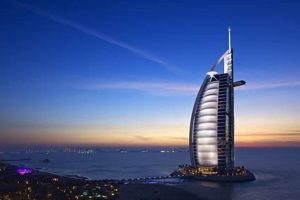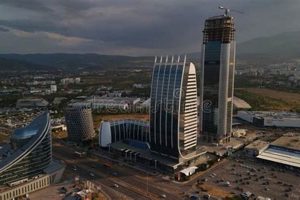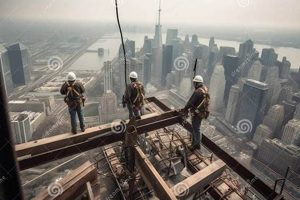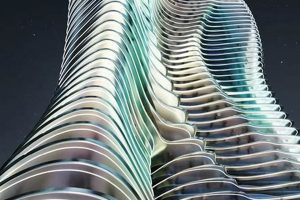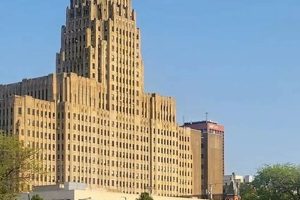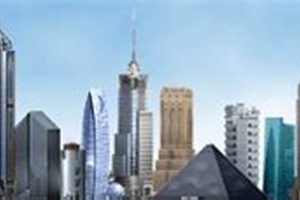Skyscrapers, towering architectural marvels that pierce the heavens, have become iconic symbols of modern cities worldwide. These colossal structures, reaching extraordinary heights, redefine urban skylines and push the boundaries of engineering prowess.
The significance of skyscrapers transcends their physical presence. They serve as economic powerhouses, housing businesses, corporate headquarters, and financial institutions that drive urban economies. Moreover, these vertical cities offer unparalleled living spaces, providing residents with breathtaking panoramic views, luxurious amenities, and convenient access to urban centers.
The history of skyscrapers is intertwined with technological advancements and architectural innovation. From the pioneering skyscrapers of the late 19th century, such as the Home Insurance Building in Chicago, to the awe-inspiring supertalls of today, like the Burj Khalifa in Dubai, these architectural wonders have constantly evolved to meet the changing needs of urban populations.
1. Height
Skyscrapers, by virtue of their extraordinary height, possess a unique ability to reshape urban skylines. Their towering presence transforms the visual landscape of cities, creating new landmarks and altering the perception of urban space.
- Vertical Dominance: Skyscrapers establish a commanding vertical presence, dominating the skyline and becoming iconic symbols of a city’s identity.
- Urban Landmarks: Their exceptional height makes them instantly recognizable landmarks, serving as points of orientation and pride for residents and visitors alike.
- City Branding: The distinctive silhouettes of skyscrapers often become synonymous with a city’s image, enhancing its global recognition and appeal.
- Tourism and Observation: Many skyscrapers incorporate observation decks or public spaces, offering breathtaking panoramic views and attracting tourists from around the world.
In summary, the height of skyscrapers plays a pivotal role in redefining skylines, establishing vertical dominance, creating urban landmarks, enhancing city branding, and fostering tourism. Their towering presence transforms the urban landscape, making them integral to the identity and visual appeal of modern cities.
2. Engineering
Skyscrapers, as architectural wonders that soar towards the sky, would not exist without the remarkable feats of engineering that push the boundaries of architectural innovation. Engineering plays a pivotal role in every aspect of a skyscraper’s design and construction, from the initial concept to the final execution.
- Structural Ingenuity: Skyscrapers require innovative structural systems to withstand immense weight, wind forces, and seismic activity. Engineers employ advanced materials, such as reinforced concrete and steel alloys, to create structures that are both strong and flexible.
- Vertical Transportation: Efficient vertical transportation is crucial in skyscrapers. Engineers design high-speed elevators and escalators to move large numbers of people quickly and safely between floors.
- Mechanical, Electrical, and Plumbing (MEP) Systems: Skyscrapers require complex MEP systems to provide essential services such as heating, ventilation, air conditioning, lighting, and plumbing. Engineers must carefully plan and integrate these systems to ensure the comfort and safety of occupants.
- Sustainability: Modern skyscrapers incorporate sustainable design principles to minimize their environmental impact. Engineers employ energy-efficient technologies, rainwater harvesting systems, and green roofs to reduce energy consumption and promote environmental responsibility.
In conclusion, engineering is the driving force behind the innovative design and construction of skyscrapers. By pushing the boundaries of architectural innovation, engineers create structures that are not only iconic landmarks but also marvels of engineering prowess, providing safe, sustainable, and technologically advanced living and working spaces.
3. Economics
Skyscrapers serve as economic powerhouses, housing businesses and driving urban economies in various ways:
- Office Space Consolidation: Skyscrapers provide centralized locations for businesses, allowing them to consolidate their operations under one roof. This efficiency improves communication, collaboration, and overall productivity, contributing to economic growth.
- Vertical Business Ecosystems: High-rise buildings can house a diverse mix of businesses, creating vertical ecosystems where companies can interact, share resources, and foster innovation. This concentration of businesses within a single structure promotes economic synergy and competitiveness.
- Urban Job Creation: The construction and maintenance of skyscrapers generate numerous employment opportunities, ranging from architects and engineers to construction workers and property managers. These jobs contribute to local economies and support the growth of urban populations.
- Property Value and Tax Revenue: Skyscrapers, as iconic landmarks and desirable addresses, increase the value of surrounding properties. This appreciation in property values generates increased tax revenue for municipalities, which can be invested in public services and infrastructure, further stimulating economic development.
In summary, skyscrapers play a vital role in driving urban economies by providing centralized business locations, fostering vertical business ecosystems, creating urban jobs, and enhancing property values. Their economic significance makes them integral to the growth and prosperity of modern cities.
4. Living Spaces
Skyscrapers have revolutionized urban living by offering unparalleled views and luxurious amenities that cater to the discerning tastes of modern city dwellers. These living spaces, perched high above the bustling streets, provide a unique combination of comfort, convenience, and exclusivity.
The panoramic views from skyscraper residences are simply breathtaking. Floor-to-ceiling windows offer unobstructed vistas of the cityscape, allowing residents to enjoy the ever-changing urban landscape from the comfort of their own homes. Whether it’s the sparkling skyline at night or the vibrant city streets below, the views from sky
scraper apartments are unmatched.
In addition to stunning views, skyscrapers also offer a wide range of luxurious amenities that enhance the living experience. Residents can enjoy state-of-the-art fitness centers, swimming pools, spas, and concierge services. Some high-rise buildings even feature private theaters, wine cellars, and rooftop gardens, providing residents with an unparalleled level of comfort and convenience.
The combination of unparalleled views and luxurious amenities makes skyscraper living highly sought-after. These exclusive residences attract professionals, celebrities, and anyone who desires a sophisticated and cosmopolitan lifestyle. However, it’s important to note that living in a skyscraper comes with a premium price tag, making it accessible only to a select few.
In conclusion, skyscrapers have transformed urban living by offering unparalleled views and luxurious amenities. These exclusive residences provide a unique combination of comfort, convenience, and exclusivity, catering to the discerning tastes of modern city dwellers. While the cost of living in a skyscraper may be high, the experience and lifestyle it offers are unmatched.
5. Urban Centers
Skyscrapers, by virtue of their strategic locations in urban centers, offer unparalleled convenience and accessibility to city hubs. This proximity to transportation, business districts, cultural attractions, and other essential amenities enhances the overall living experience for skyscraper residents.
- Commuting Convenience: Skyscrapers located near public transportation hubs, such as subway stations or bus terminals, provide residents with easy access to various parts of the city. This convenience reduces commuting time and stress, making it easier for residents to get to work, school, or leisure activities.
- Business Proximity: Many skyscrapers are situated in the heart of business districts, offering convenient access to offices, financial institutions, and corporate headquarters. This proximity benefits professionals who work in these areas, as they can easily walk to their workplace or attend meetings without the need for lengthy commutes.
- Cultural Attractions: Skyscrapers in close proximity to cultural attractions, such as museums, theaters, and art galleries, provide residents with easy access to entertainment and cultural enrichment. This proximity enhances the overall quality of life for residents, as they can easily enjoy the city’s cultural offerings.
- Essential Amenities: Skyscrapers often include retail spaces on the lower floors, offering residents convenient access to essential amenities such as grocery stores, pharmacies, and restaurants. This convenience simplifies daily life for residents, as they can easily access these amenities without having to venture far from their homes.
In conclusion, the convenient access to city hubs provided by skyscrapers is a key factor that enhances the living experience for residents. The proximity to transportation, business districts, cultural attractions, and essential amenities makes skyscrapers highly desirable and contributes to their popularity in urban centers worldwide.
6. Sustainability
Incorporating eco-friendly features into skyscrapers is a growing trend as architects and developers recognize the importance of sustainability in modern construction. Sustainable skyscrapers aim to minimize their environmental impact throughout their lifecycle, from design and construction to operation and maintenance.
- Energy Efficiency: Sustainable skyscrapers employ various techniques to reduce energy consumption, such as high-performance building envelopes, energy-efficient lighting systems, and renewable energy sources like solar panels and wind turbines. These measures minimize the building’s carbon footprint and operating costs.
- Water Conservation: Water-saving fixtures, rainwater harvesting systems, and drought-tolerant landscaping are incorporated into sustainable skyscrapers to reduce water usage. These measures conserve precious water resources and mitigate the impact on local water supplies.
- Material Selection: Sustainable skyscrapers prioritize the use of environmentally friendly materials, such as recycled steel, low-VOC paints, and sustainably sourced wood. These materials reduce the building’s embodied carbon and promote resource conservation.
- Waste Management: Sustainable skyscrapers implement comprehensive waste management plans to reduce, reuse, and recycle waste generated during construction and operation. This approach minimizes the building’s contribution to landfills and promotes circular economy principles.
By incorporating these eco-friendly features, sustainable skyscrapers not only reduce their environmental impact but also create healthier and more comfortable indoor environments for occupants. They contribute to the overall sustainability of urban environments and set a positive example for future developments.
7. Cultural Icons
Skyscrapers, with their towering heights and iconic designs, have become cultural icons that embody the spirit and aspirations of cities and nations. They transcend their functional purpose as buildings and evolve into symbols of urban identity, national pride, and architectural prowess.
- Architectural Landmarks: Skyscrapers often become defining landmarks that represent a city’s unique character and skyline. Their distinctive silhouettes and innovative designs make them instantly recognizable and associated with a particular location.
- National Identity: In many countries, skyscrapers serve as symbols of national identity and progress. They showcase a nation’s architectural achievements and economic strength, becoming a source of pride and patriotism.
- Cultural Expression: Skyscrapers can embody cultural values and aspirations. Their design and ornamentation often reflect the artistic and cultural heritage of a city or nation, expressing the creativity and vision of its people.
- Tourism and Global Recognition: Iconic skyscrapers attract tourists from around the world, eager to experience these architectural marvels and capture the essence of a city. They become symbols of global recognition, enhancing a city’s reputation and contributing to its tourism industry.
In conclusion, skyscrapers have evolved from mere structures into powerful cultural icons that represent the identity, aspirations, and achievements of cities and nations. They stand as testaments to human ingenuity, architectural innovation, and the enduring connection between architecture and culture.
8. Historical Legacy
The historical legacy of skyscrapers is deeply intertwined with the evolution of architecture and engineering, marking significant milestones in the
pursuit of vertical construction.
- Pioneering Structures:
Early skyscrapers, such as the Home Insurance Building in Chicago (1885), pushed the boundaries of height and structural innovation, establishing the foundation for future advancements. - Art Deco Era:
The 1920s and 1930s witnessed the rise of Art Deco skyscrapers, characterized by their distinctive ornamentation and stepped setbacks. The Chrysler Building in New York City (1930) exemplifies this era’s architectural grandeur. - Post-World War II Boom:
Following World War II, a surge in skyscraper construction led to the development of new technologies and materials. The Lever House in New York City (1952) showcased the International Style’s emphasis on simplicity and glass facades. - Supertall Era:
The late 20th century ushered in the era of supertalls, skyscrapers exceeding 300 meters (984 feet) in height. Buildings like the Petronas Towers in Kuala Lumpur (1998) and the Burj Khalifa in Dubai (2010) represent the pinnacle of engineering achievement.
The historical legacy of skyscrapers reflects the ongoing quest for architectural innovation, pushing the limits of design and engineering. Each era has left its mark on the skyline, showcasing the evolution of styles, technologies, and the relentless pursuit of verticality.
Skyscraper FAQs
This section addresses frequently asked questions and misconceptions surrounding skyscrapers, providing concise and informative answers.
Question 1: What is the defining characteristic of a skyscraper?
Skyscrapers are distinguished by their extraordinary height, typically exceeding 150 meters (492 feet). They are designed to accommodate a large number of occupants and often house various functions such as offices, residential units, or retail spaces.
Question 2: What are the main advantages of building skyscrapers?
Skyscrapers offer numerous advantages, including efficient land utilization in densely populated urban areas, increased floor space for various uses, and enhanced views and natural light for occupants.
Question 3: Are skyscrapers safe in the event of natural disasters?
Modern skyscrapers are designed with robust structural systems and advanced safety measures to withstand earthquakes, high winds, and other natural disasters. They incorporate features such as reinforced concrete cores, wind-resistant facades, and emergency evacuation plans.
Question 4: How do skyscrapers contribute to urban sustainability?
Sustainable skyscrapers employ various eco-friendly strategies to reduce their environmental impact. They incorporate energy-efficient lighting systems, water conservation measures, and renewable energy sources to minimize their carbon footprint and promote resource conservation.
Question 5: What are the challenges associated with skyscraper construction?
Skyscraper construction presents several challenges, including complex engineering design, high material costs, logistical difficulties in transporting materials to great heights, and the need for specialized construction techniques.
Question 6: How do skyscrapers shape the identity of cities?
Skyscrapers have become iconic symbols of cities around the world. Their unique designs and impressive heights contribute to a city’s skyline, reflecting its economic power, architectural achievements, and cultural aspirations.
Summary:Skyscrapers are remarkable feats of engineering that offer numerous advantages while also presenting unique challenges. Their design and construction require careful planning and advanced technologies to ensure safety and sustainability. As symbols of urban progress and innovation, skyscrapers continue to shape the skylines and identities of cities worldwide.
Transition:This concludes our exploration of skyscrapers. Moving forward, we will delve into a more detailed examination of their various aspects, including design, construction, and the impact they have on urban environments.
Skyscraper Tips
Skyscrapers, with their towering heights and complex designs, require meticulous planning and execution to ensure their safety, functionality, and sustainability. Here are a few tips to consider when designing, constructing, or managing skyscrapers:
Tip 1: Prioritize Structural Integrity and Safety
Skyscrapers must withstand various forces, including wind, earthquakes, and potential collisions. Employ robust structural systems, such as reinforced concrete cores and wind-resistant facades, to ensure the building’s stability and integrity. Implement comprehensive safety protocols, including fire detection and suppression systems, emergency evacuation plans, and regular maintenance checks.
Tip 2: Optimize Space and Functionality
Maximize usable space by employing efficient floor plans and utilizing vertical space effectively. Consider mixed-use developments to accommodate various functions, such as offices, residential units, and retail spaces, within a single skyscraper. Design flexible and adaptable spaces that can be reconfigured to meet changing needs.
Tip 3: Embrace Sustainable Design Principles
Implement eco-friendly strategies to reduce the skyscraper’s environmental impact. Incorporate energy-efficient lighting systems, water conservation measures, and renewable energy sources to minimize energy consumption and carbon emissions. Utilize sustainable materials and construction practices to promote resource conservation and reduce waste.
Tip 4: Ensure Efficient Vertical Transportation
Plan for efficient vertical transportation systems to move occupants and visitors quickly and safely throughout the skyscraper. Utilize high-speed elevators, escalators, and potentially other innovative transportation solutions to minimize wait times and optimize building flow. Consider accessibility features for individuals with disabilities and ensure compliance with relevant building codes.
Tip 5: Enhance Occupant Comfort and Well-being
Design skyscrapers with occupant comfort and well-being in mind. Provide access to natural light and ventilation to create healthy and inviting indoor environments. Implement noise reduction measures and incorporate amenities such as fitness centers, green spaces, and communal areas to enhance the overall experience for occupants.
By following these tips, architects, engineers, and building managers can create skyscrapers that are not only structurally sound and functional but also sustainable, efficient, and conducive to the well-being of their occupants. These towering structures will continue to shape the skylines of cities worldwide while providing valuable spaces for living, working, and thriving.
Conclusion
Skyscrapers, with their towering heights and architectural prowess, have reshaped skylines and redefined urban living. They stand as testaments to human ingenuity, engineering advancements, and the pursuit of vertical frontiers.
This exploration has shed light on the multifaceted nature of skyscrapers, encompassing their economic significance, sustainability initiatives, cultural impact, and historical evolution. These architectural wonders serve as hubs for business, provide unparalleled living spaces, embody national pride, and push the boundaries of design and construction.
As we look towards the future, skyscrapers will continue to play a pivotal role in shaping our cities. The ongoing quest for innovation and sustainability will undoubtedly lead to even more awe-inspiring and environmentally conscious stru
ctures. The skyscraper, as an architectural marvel and a symbol of human ambition, will remain an enduring marvel, reaching for the heavens and shaping the face of our urban landscapes for generations to come.


